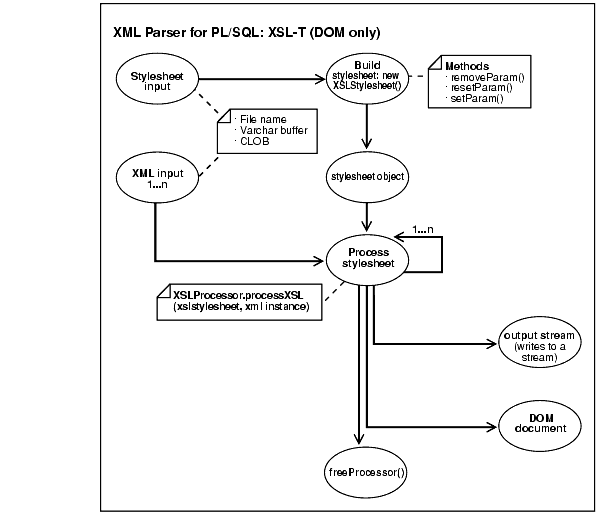Release 2 (9.2)
Part Number A96621-01
Home |
Book List |
Contents |
Index |
 Master Index |
 Feedback |
| Oracle9i XML Developer's Kits Guide - XDK Release 2 (9.2) Part Number A96621-01 |
|
This chapter contains the following sections:
Extensible Stylesheet Language Transformation, abbreviated XSLT (or XSL-T), describes rules for transforming a source tree into a result tree. A transformation expressed in XSLT is called a stylesheet.
The transformation specified is achieved by associating patterns with templates defined in the stylesheet. A template is instantiated to create part of the result tree.
This PLSQL implementation of the XSL processor follows the W3C XSLT working draft (rev WD-xslt-19990813) and includes the required behavior of an XSL processor in terms of how it must read XSLT stylesheets and the transformations it must effect.
The types and methods described in this document are made available by the PLSQL package, xslprocessor().
Figure 21-1 shows the XML Parser for PL/SQL XSLT Processor main functionality.
The XML document can be input 1 through n times.
XSLProcessor.processXSL(xslstylesheet,xml instance) procedure, where:
XSLStylesheet() procedure. The following methods are available for this procedure:
This produces a stylesheet object which then inputs the "Process Stylesheet" step using procedure, XSLProcessor.processXSL(xslstylesheet,xml instance).

The following is the default behavior for the XML Parser for PL/SQL XSLT Processor:
This XSL file inputs the xslsample.sql.
<?xml version="1.0"?> <!-- Identity transformation --> <xsl:stylesheet xmlns:xsl="http://www.w3.org/1999/XSL/Transform" version="1.0"> <xsl:template match="*|@*|comment()|processing-instruction()|text()"> <xsl:copy> <xsl:apply-templates select="*|@*|comment()|processing-instruction()|text()"/> </xsl:copy> </xsl:template> </xsl:stylesheet>
|
 Copyright © 2001, 2002 Oracle Corporation. All Rights Reserved. |
|